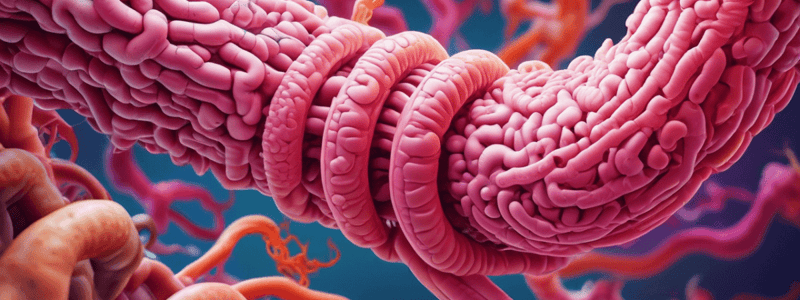Podcast
Questions and Answers
What is the primary function of the small intestine?
What is the primary function of the small intestine?
- Filtration and excretion
- Respiration and circulation
- Absorption and digestion (correct)
- Synthesis and storage
What is the function of villi in the small intestine?
What is the function of villi in the small intestine?
- Production of bile
- Release digestive enzymes (correct)
- Secretion of hormones
- Storage of nutrients
What is the role of microvilli in the small intestine?
What is the role of microvilli in the small intestine?
- Regulate blood pressure
- Increase absorptive capacity (correct)
- Produce insulin
- Store excess water
Which hormone inhibits gastric secretion in the small intestine?
Which hormone inhibits gastric secretion in the small intestine?
What stimulates the enterogastric reflex in the small intestine?
What stimulates the enterogastric reflex in the small intestine?
What is the primary function of the jejunum in the small intestine?
What is the primary function of the jejunum in the small intestine?
Which segment of the small intestine is responsible for reabsorption of vitamin B12?
Which segment of the small intestine is responsible for reabsorption of vitamin B12?
What stimulates the opening of the ileocecal valve?
What stimulates the opening of the ileocecal valve?
What process describes the return of bile acids to the liver from the ileum?
What process describes the return of bile acids to the liver from the ileum?
How does the duodenal pH affect gastric emptying into the duodenum?
How does the duodenal pH affect gastric emptying into the duodenum?
Flashcards
Small intestine function
Small intestine function
Absorption and digestion of nutrients from food
Function of villi
Function of villi
Release digestive enzymes to break down food further.
Role of microvilli
Role of microvilli
Increase the absorptive capacity of the small intestine.
Secretin's Function
Secretin's Function
Signup and view all the flashcards
Enterogastric reflex stimulus
Enterogastric reflex stimulus
Signup and view all the flashcards
Jejunum main function
Jejunum main function
Signup and view all the flashcards
Ileum function
Ileum function
Signup and view all the flashcards
Ileocecal valve opening
Ileocecal valve opening
Signup and view all the flashcards
Enterohepatic circulation
Enterohepatic circulation
Signup and view all the flashcards
Duodenal pH effect
Duodenal pH effect
Signup and view all the flashcards
Study Notes
Small Intestine Structure and Function
- The small intestine is approximately 20 feet long and its primary function is absorption and digestion.
- It consists of four parts: duodenum, jejunum, ileum, and ileocecal valve.
- The mucosal lining of the small intestine is covered with villi, which are tiny fingerlike projections.
- Each villus contains goblet cells that release digestive enzymes, secrete mucus, and absorb nutrients.
- The villi are also covered with microvilli, which are located on the epithelial cells, forming a double set known as the brush border.
- The brush border increases the surface area of the small intestine, significantly increasing its absorptive capacity.
Digestive Process in the Small Intestine
- The intestinal phase of digestion involves neural and hormonal responses.
- The neural response, the enterogastric reflex, is responsible for opening the pyloric sphincter and decreasing gastric motility and acid production.
- In the duodenum, bile from the liver, enzymes from the pancreas, and chyme from the stomach come together to complete the digestive process.
- The duodenum and jejunum contain receptors that sense acidity, osmotic pressure, and products of digestion such as fats and peptides.
Functions of Small Intestine Segments
- The primary function of the duodenum is to complete the digestive process.
- The primary function of the jejunum is absorption of nutrients such as amino acids, glucose, iron, calcium, and fat-soluble vitamins.
- The primary function of the ileum is the reabsorption of vitamin B12 and the return of bile acids to the liver through the enterohepatic circulation process.
- The gastroileal reflex stimulates the opening of the ileocecal valve, which controls the release of digestive contents into the large intestine.
Studying That Suits You
Use AI to generate personalized quizzes and flashcards to suit your learning preferences.




